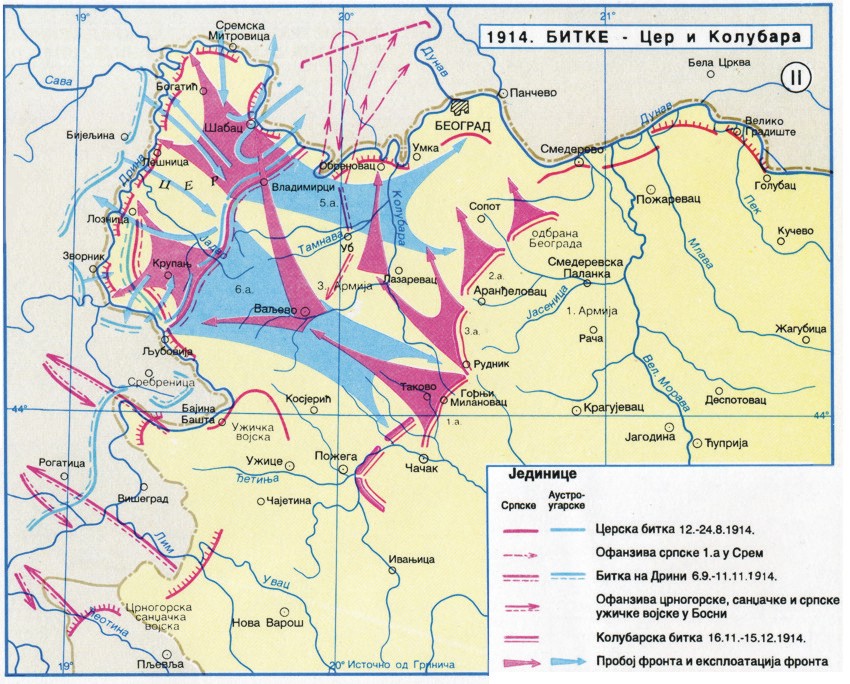Centenary of Battle of Cer

 The decisive stage of the Battle of Cer, which ended as the first major Allied victory in World War I - and one that was won by the Serbian forces - took place in the night between August 15 and 16, 1914.
The decisive stage of the Battle of Cer, which ended as the first major Allied victory in World War I - and one that was won by the Serbian forces - took place in the night between August 15 and 16, 1914.
The fact that tiny Serbia managed to defeat the Austro-Hungarian troops so comprehensively at Cer despite being at a great disadvantage in every sense was met with shock and disbelief in Vienna and Berlin, as well as with jubilation among the Allies, and Serbia's reputation grew unexpectedly.
Greatly exhausted by the Balkan Wars against Turkey and Bulgaria - which it won at the cost of many casualties - Serbia, a small country that was tired and in need of reconsolidation, was attacked by Austro-Hungary, which made no secret of its intention to destroy Serbia completely.
The reasoning of top officials in Vienna was that the perfect time has come to wipe weak Serbia off the map in what was expected to be a small war.
The Austrian Fifth Army began a forced march towards the Drina River in the Loznica area on August 12 as the Austro-Hungarian Second Army marched towards the Sava River in the area between Sremska Mitrovica and Sabac.
Squads of Serbian troops took up the fight on the two rivers, resisting the advance of an overwhelming, incomparably better-equipped Austro-Hungarian force for four days from August 12 to 15.
In the late afternoon of August 14, General Stepa Stepanovic, who was in command of the Second Army following the return of Field Marshal Radomir Putnik, received the order to retake Sabac.
In the morning hours of August 15, faced with an Austro-Hungarian onslaught towards Valjevo, the Serbian Supreme Command ordered the Third Army to block the path to Valjevo from the valley of the Jadar River in any way possible, while the Second Army was ordered to move towards Tekeris and attack the enemy's left flank.
There, on the south-western slopes of Mt. Cer near Tekeris, the two forces clashed heavily in the night between April 15 and 16, with the bitter fighting ending in a resolute Serbian victory.
The Austro-Hungarian 21st Division retreated and the 8th Corps followed suit - eventually, the Austro-Hungarian Fifth Army withdrew across the Drina.
Hit by panic after the Serbs had won surprise victories, the Austro-Hungarian troops were in a state of disarray and general low morale.
The army was defeated, fleeing in a reckless, wild and panicky fashion - a routed force, or rather, a scattered mob, was rushing towards the border in mindless fear, Egon Erwin Kisch - a famous journalist and intellectual who was with the Austro-Hungarian troops at the time - wrote in his diary sometime in late August 1914, portraying the atmosphere among his comrades.
It was the first major Allied victory in World War I.
With the exception of 4,500 prisoners of war, none of the approximately 200,000 Austro-Hungarian soldiers who had invaded Serbia remained in the country as Operation Cer ended on August 24.
The Austro-Hungarian casualties in the bloody fighting totalled 27,000, with around 16,500 Serbian soldiers put out of action, including 2,107 dead.
Operation Cer ended following a pursuit of the enemy troops all the way to the Drina and after the closing battles around Sabac on August 21-24, 1914.
In the wake of the resolute victory and his success as a commander, General Stepa Stepanovic was awarded the rank of field marshal.
Извор: tanjug.rs

